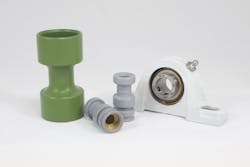Applicator Tips for Precise Non-Stick Coatings
By Jeff Elliott
Known most commonly as a coating for non-stick pans, polytetrafluorethylene (PTFE) is offered in both liquid and powder forms. But its heat resistance, chemical inertness, excellent dielectric stability, and low coefficient of friction make it useful in other applications as well. This versatility applies to a variety of parts sizes and configurations manufactured from carbon steel, aluminum, stainless steel, alloys and other metals, as well as glass, fiberglass, some rubber, and plastic.
PTFE coatings can enhance performance and increase the value of products by creating functional surfaces that resolve issues such as friction, sticking, corrosion, noise, and abrasion.
Precise application
Today, the application of PTFE and other functional coatings has become precise and highly automated. Investment in production equipment and efforts to meet environmental regulations have led PTFE applicators to partner with companies that previously used to do the work in-house, or send it out to local applicators.
“In this industry, the non-stick finishes we provide are something the customer could do themselves by investing heavily in equipment to coat parts in-house," says George Osterhout of Orion Industries, one of the largest Chemours Licensed Applicators for PTFE coatings in North America.
According to Osterhout, the difference in quality between applicators is usually defined by two primary factors: the proper and thorough pretreatment of parts prior to coating, and the ability to apply coatings as thin as 10 microns with little to no variance between parts with a tolerance of +/- 3 microns.
To assure that level of precision, some applicators design and build their own production lines from the ground up. These systems must be configured to accommodate a wide range of parts in different sizes and geometries.
Production of coated prototypes usually starts the application process. After finding the ideal coating solution and calculating the volume of the application, the company may create the custom tooling and the semi- or fully-automated machinery to meet the requirements for short-run to high-speed production.
Then, the surface must be prepared before spray coating. Pretreatment lines may include automatic and manual grit blasting operations, along with large and medium tumble grit blasting machines and medium tumble blasters. Consistently pre-treating parts is necessary to optimize adhesion of each coating.
In turn, systems must be designed to deliver precise metering of spray coatings. Controls should achieve consistent application within tight tolerances and with very little overspray to save on material costs.
“Through precise control of the coatings, the customer knows each part will be virtually identical [within less than 1% variance] to the one produced before or after,” says Osterhout.
The parts then travel through an oven for curing. Infrared ovens with convection air tend to take up to 1/3rd the curing time of gas ovens. For PTFE, curing should be at temperatures up to 850ºF.
Low friction coatings for silicone rubber
Some manufacturers develop their own line of coatings to change the coefficient of friction or reduce collection of dust or dirt on finished coated surfaces. As for silicone rubber, which is widely used for tubes, seals, and rollers, the material is tacky and can cling to any object it comes in contact with – even other silicone surfaces. This is due to the materials high friction coefficient, which can exceed 1.0.
Dry film lubricants
Typically engineers are schooled in oil or grease-based lubrication techniques, but not nearly as much time or attention is spent on dry film lubricants.
Unlike oil and grease that can migrate away, dry film lubricants continue to transfer back and forth on the mating surfaces and stay in place for a much longer time. Also, dry film coatings serve as a thin cushion, spreading high point loads in bearings and reducing element fatigue.
For this, graphite and molybdenum disulfide (Moly) are often used. Moly-disulfide coatings are recommended for conditions of heavy wear, particularly high-load situations. This includes bearing-type applications where one part rolls or slides over another part. Graphite coatings are generally used in wet service or at elevated temperatures.
PTFE can also serve a dry film lubricant, though typically for light to moderate applications. PTFE is often incorporated with Moly and graphite into unique formulations.
To learn more about the coating industry, contact Orion Industries at (773) 282-9100, e-mail [email protected] or visit www.orioncoat.com.

